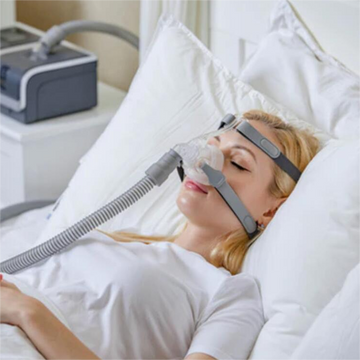Sleep apnea is a serious sleep disorder that affects millions of people worldwide. If left untreated, it can lead to high blood pressure, heart disease, stroke, and even death. Continuous Positive Airway Pressure (CPAP) therapy is the most effective treatment for sleep apnea. In this article, we'll cover everything you need to know about CPAP therapy, including what it is, how it works, its benefits and drawbacks, and how to use it effectively.

1. What is Sleep Apnea?
Sleep apnea is a sleep disorder that causes your breathing to stop and start repeatedly while you sleep. It can be caused by a blocked airway, a problem with the muscles that control breathing, or a combination of both. There are three types of sleep apnea: obstructive sleep apnea, central sleep apnea, and complex sleep apnea syndrome. Obstructive sleep apnea (OSA) is the most common type and occurs when the muscles in the back of your throat fail to keep your airway open, despite your efforts to breathe.
2. How does CPAP Therapy Work?
CPAP therapy works by delivering a continuous stream of air pressure to your airway through a mask that fits over your nose and mouth or just your nose. This air pressure acts as a splint to keep your airway open and prevent it from collapsing, which reduces or eliminates the symptoms of sleep apnea.
3. Types of CPAP Machines
Standard CPAP Machines: These machines deliver a consistent, continuous level of air pressure throughout the night to help keep your airway open. They typically have a single pressure setting that is determined by your healthcare provider based on the severity of your sleep apnea.
- Auto-Adjusting CPAP Machines: These machines can adjust the pressure they deliver based on your breathing patterns throughout the night. They use algorithms to detect when you're experiencing apneas or hypopneas and increase the pressure accordingly, which can help improve the comfort and effectiveness of therapy.
- Bi-Level Positive Airway Pressure (BiPAP) Machines: These machines deliver different levels of air pressure during inhalation and exhalation, which can make it easier to breathe for people with certain respiratory conditions. They're often recommended for people who have trouble tolerating the constant pressure of a standard CPAP machine.
- Travel CPAP Machines: These machines are designed to be compact and portable, making them a convenient option for people who need to use CPAP therapy while travelling. They typically have features like lightweight construction, battery power options, and compact carrying cases.
4. Benefits of CPAP Therapy
The benefits of CPAP therapy include:
- Improved quality of sleep: By keeping your airway open and reducing the number of apneas and hypopneas you experience during the night, CPAP therapy can help you achieve deeper, more restful sleep. This can lead to feeling more refreshed and energized during the day.
- Reduced daytime sleepiness and fatigue: Many people with sleep apnea experience excessive daytime sleepiness and fatigue due to poor-quality sleep. CPAP therapy can help alleviate these symptoms, allowing you to feel more alert and focused during the day.
- Lower blood pressure: Sleep apnea has been linked to high blood pressure, and CPAP therapy can help lower blood pressure in people with sleep apnea. This can reduce the risk of heart disease and stroke.
- Decreased risk of heart disease, stroke, and diabetes: By improving sleep quality and lowering blood pressure, CPAP therapy can also help reduce the risk of developing these serious health conditions.
- Improved mood and overall well-being: Many people with sleep apnea report feeling irritable, depressed, or anxious due to poor sleep quality and daytime sleepiness. CPAP therapy can help improve mood and overall well-being by alleviating these symptoms and improving sleep quality.
5. Side Effects of CPAP Therapy
The most common side effects of CPAP therapy include:
- Dry or stuffy nose
- Skin irritation or pressure sores from the mask
- Sore throat or dry mouth
- Headaches
- Abdominal bloating or discomfort
- Claustrophobia or anxiety related to the mask
6. Common Problems with CPAP Therapy and How to Fix Them
Some common problems with CPAP therapy include:
- Mask leaks
- Pressure intolerance
- Mouth breathing
- Nasal congestion
- Discomfort or irritation from the mask
- Noise from the machine
7. Tips for Successful CPAP Therapy
Here are some tips for successful CPAP therapy:
- Use your CPAP machine every night
- Keep your CPAP machine and equipment clean
- Find a comfortable mask that fits well
- Use a heated humidifier to reduce dryness and irritation
- Practice good sleep hygiene
- Stay consistent with your treatment plan
8. Alternatives to CPAP Therapy
If you are unable to tolerate CPAP therapy or do not respond to it, there are several alternative treatments available, including:
1. Oral Appliances
Oral appliances are a popular alternative to CPAP therapy. They are custom-made devices that fit in the mouth like a sports mouthguard. Oral appliances work by repositioning the jaw and tongue to keep the airway open during sleep. They are easy to use, portable, and do not require electricity or a mask.
2. Surgery
Surgery is another alternative to CPAP therapy. It is typically recommended for people who have severe sleep apnea or are unable to tolerate other treatments. Several surgical procedures can be used to treat sleep apnea, including:
- Uvulopalatopharyngoplasty (UPPP): This procedure removes excess tissue from the back of the throat, including the uvula and tonsils.
- Maxillomandibular Advancement (MMA): This surgery involves moving the upper and lower jaw forward to enlarge the airway.
- Tracheostomy: This procedure involves creating a hole in the neck to bypass the blocked airway.
3. Positional Therapy
Positional therapy is a treatment that involves changing sleeping position to reduce the risk of airway obstruction. It is typically recommended for people who have mild to moderate sleep apnea that occurs mainly when sleeping on their back. Positional therapy can involve using special pillows or devices to keep the body in a side-sleeping position.
4. Lifestyle Changes
Lifestyle changes can also help manage sleep apnea symptoms. They include:
- Weight loss: Losing weight can help reduce the severity of sleep apnea symptoms.
- Exercise: Regular exercise can help improve sleep quality and reduce the risk of sleep apnea.
- Avoiding alcohol and sedatives: These substances can relax the muscles in the throat, making it more difficult to breathe during sleep.


